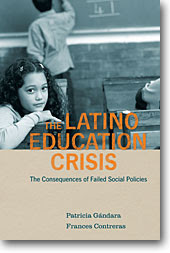 The Latino education crisis is not simply a result of immigration.
The Latino education crisis is not simply a result of immigration. The US population is more familiar with the term Latino and many still use the Hispanic. But what this word mean for people who themselves are grouped in? Americans see this gender as Latino/Hispanic, but those Hispanic American and even recent arrived from Spanish speaking world, don't see themselves as such. Hispanics belong to other smaller groups, mostly classified by country. They -the people under the umbrella of Latino, don't call themselves Latino, they are Colombians, Peruvians, Mexicans, Spaniards, etc. And that is a problem for the Hispanic community. They haven't been able to work as a great mass, rather they are divided in small groups of different interests.
Among those problems is education. At the end of November 2008, a new book from The Civil Rights Project/Proyecto Derechos Civiles (CRP/PDC) at UCLA's Graduate School of Education and Information Studies, tries to lurk into educational landscape for Hispanics.
The Latino Education Crisis: The Consequences of Failed Social Policies is the book authored by CRP Co-Director, Professor Patricia Gándara and Frances Contreras, professor at University of Washington. The book documents where we are now, and where we might go, in our education, and care of, the Latino population.
Fast-growing and largely neglected, this population's characteristics are documented in this article as much as the book itself, with statements like "the overwhelming majority of Latino students are native-born, and, in spite of the recent large increase in Latino immigration, the native-born population is still growing at a faster rate than is immigration." So, forget about those uneducated parents who happen to arrive to the promised land, these kids are Americans and we all should be concerned about.
"Almost one in five students across the country is Latino; by 2050 one in three will be", continues the cited article. Definitely, Gándara and Contreras' book is a call to action and will be essential reading for everyone involved in planning the future of American schools.
Weblog Award Finalist, Education Policy Blog, states having finished reading the book and lists the policy agenda to address the needs in Latino Education.
If you want to receive my future posts regularly for FREE, please subscribe in a reader or by e-mail. If you have concerns, Contact Me at anytime.









0 Comments